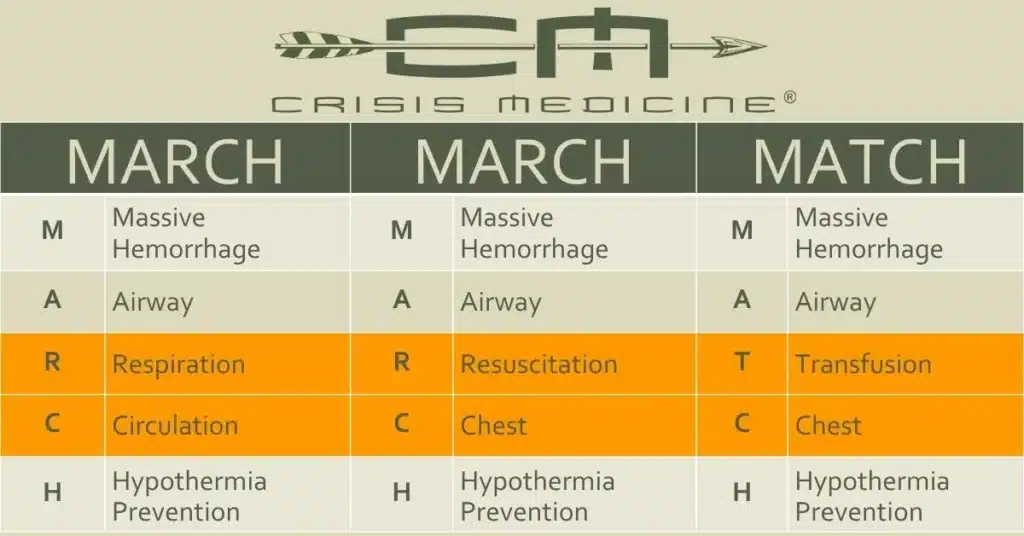
Tactical Resuscitation in 2025: Rethinking MARCH for the Blood Product Era
- Posted by Mike Shertz MD/18D
- Categories (C) Circulation, MARCH
Co-TCCC considered changing the MARCH mnemonic to include resuscitation, or more specifically transfusion.
Researched and written by Mike Shertz, MD/18D, not AI
🕖 Reading Time, 4 minutes
One suggestion was to change the mnemonic to MATCH: Massive hemorrhage, Airway, Transfusion, Chest, and Hypothermia prevention and management.
Others preferred to keep the MARCH mnemonic, but add resuscitation: Massive hemorrhage, Airway, Resuscitation, Chest, and Hypothermia prevention and management.
Both of these versions of the mnemonic emphasize the importance of providing blood products to the casualty as soon as possible.
Evolving analysis of WDMET data shows 10% of Vietnam combat casualties died from bleeding within their torso2, 3 and possibly only 3% died from tension pneumothorax.1 Originally, tension was reported as 10%, but reappraisals of that data suggest it might have been much lower. Therefore, moving resuscitation with blood products higher in the mnemonic, above treating possible tension pneumothorax, makes sense.
In concept, with an infinite quantity of whole blood, rescuers/providers could continue to transfuse or resuscitate a trauma patient with uncontrolled internal hemorrhage until surgical repair could be achieved.
However, IV fluid resuscitation is not the same as blood products for hypotensive trauma patients with ongoing bleeding. Functionally, there is no data showing IV fluid improves survival in actively bleeding trauma patients. Even using the concept of hypotensive resuscitation, providing IV fluid only to maintain MAPs of 50 mmHg or systolic blood pressures of 70 to 80 mmHg in trauma patients with uncontrolled and ongoing bleeding, it is only a short-term temporizing measure. Moreover, there is no human data showing its safety for durations longer than one hour.
There is a suggestion tension ptx during the GWOT may have only occurred in about 1% of casualties. The body armor used in the GWOT was more robust compared to flak vests used in Vietnam. Flak vests were designed to stop shrapnel, which are large, non-aerodynamic pieces of metal, but with much less protection against GSWs. Further, in the GWOT, the most primary mechanism of injury was from IED blasts, rather than shrapnel, which also might account for a lower rate of tension ptx.4
The Ranger Regiment uses the phrase: “A needle in the arm before a needle in the chest.”
Thereby specifically, recommending resuscitation before attempting decompression.
Based on this analysis, which MARCH mnemonic you use would seem to be predicated on whether you can provide blood products to your hypotensive trauma patient who has ongoing uncontrolled internal hemorrhage.
If you have the availability of blood products, then controlling massive external hemorrhage, establishing an airway, and resuscitating with blood or more specifically transfusing, makes sense before considering less common etiologies for hypotension such as tension pneumothorax. Tension typically takes at least 20 minutes post injury to occur. Providers carrying blood can better serve casualties by using MATCH.
If you do not have any blood products, then the typical MARCH mnemonic of massive hemorrhage, airway, respiration (largely the concern for tension pneumothorax), circulation, and hypothermia prevention and management still seems reasonable.
References
1 McPherson JJ, Feigin DS, Bellamy RF. Prevalence of tension pneumothorax in fatally wounded combat casualties. J Trauma. 2006 Mar;60(3):573-8. doi: 10.1097/01.ta.0000209179.79946.92. PMID: 16531856.
2 Evaluation of Wound Data and Munitions Effectiveness in Vietnam, Volume 1. December, 1970
3 Eastridge BJ, Mabry RL, Seguin P, Death on the battlefield (2001-2011): implications for the future of combat casualty care. J Trauma Acute Care Surg. 2012 Dec;73(6 Suppl 5):S431-7. doi: 10.1097/TA.0b013e3182755dcc.
4 Nato War Surgery Manual, 2018
Related:
Dr. Mike Shertz is the Owner and Lead Instructor at Crisis Medicine. Dr. Shertz is a dual-boarded Emergency Medicine and EMS physician, having spent over 30 years gaining the experience and insight to create and provide his comprehensive, science-informed, training to better prepare everyday citizens, law enforcement, EMS, and the military to manage casualties and wounded in high-risk environments. Drawing on his prior experience as an Army Special Forces medic (18D), two decades as an armed, embedded tactical medic on a regional SWAT team, and as a Fire Service and EMS medical director.
Using a combination of current and historical events, Dr. Shertz’s lectures include relevant, illustrative photos, as well as hands-on demonstrations to demystify the how, why, when to use each emergency medical procedure you need to become a Force Multiplier for Good.




